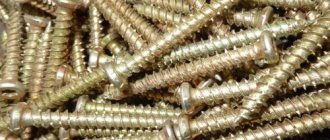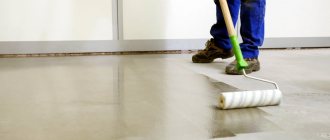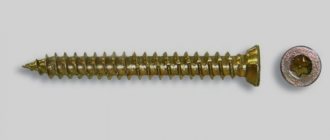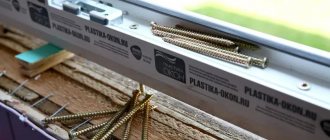Concrete is one of the most common materials in the construction industry. Building structures erected from it are part of various buildings. Owners of apartments and private houses who have carried out renovations at least once know how strong solid walls and internal partitions made of concrete are. When improving a home, there is a need to secure interior items, electrical equipment, and shelves in a concrete mass. For these purposes, a concrete dowel is used, which is a special self-tapping screw for screwing into a material with increased strength.
Screws for concrete
What material is a concrete screw made of?
Concrete fasteners are made from various materials with an increased margin of safety. A self-tapping screw screwed into the concrete mass provides reliable fixation. It does not deform under loads.
The following materials are used to make concrete dowels::
- carbon metal, which is an alloy of iron and carbon;
- stainless steel, which contains alloying elements;
- a copper-zinc alloy called brass.
Screwing the dowel into the concrete base with a wrench
In most cases, a concrete screw is made of carbon metal, the strength of which allows the hardware not to deform when screwed into solid concrete.
Fastening technology
Diagram of the dowel connection device
To install the dowel, you will need to perform a number of operations in the following sequence: make markings, drill a mounting hole, install the mount in the prepared hole.
Calculations and markings
The requirements for dowel connections are determined by SNiP 2.01.07-85; when installing dowels, the following rules must be observed:
- The crowns of the log house, corners and junctions of internal walls are subject to fastening;
- Seating places are located along the entire perimeter of the log house at a distance of 1.5-2.0 m;
- Each beam must be fastened to the lower and upper rows with a separate dowel;
- In each crown, the landing hole is shifted by 0.5 m, repeating the configuration is allowed after 2-3 rows;
- Holes are drilled in the center of the beam, with a depth of 15-20 mm greater than the length of the dowels.
Drilling
To drill mounting holes with a diameter of more than 12 mm, use low-speed drills with a power of at least 1200 W with two handles. The drill must meet the following requirements: exceed the length of the mounting pins by 30-35 mm and ensure chip removal. The best solution would be to use wood router bits. It is necessary to decide on the diameter of the drill and dowel at the design stage; you should have 7-8 drills in stock.
A hole is drilled in two crowns at once; to prevent shifting, the upper and lower beams must be securely fixed; for this you can use construction staples.
Installation
The dowels are installed in the mounting holes with tension; for this, significant force must be applied; the deeper the rod goes into the hole, the greater the force must be applied. The danger is that when driven into the timber, the dowel may crack and the upper part may become wet. You can reduce friction with a soap solution; you cannot use paraffin or technical lubricants for these purposes.
You should have a wooden or rubber mallet, a heavy and a light hammer on hand. The blows are applied strictly vertically; when using a metal tool, it is necessary to use a protective pad made from a piece of thin board or multi-layer plywood. If a crack develops in the rod during installation, it must be drilled out and the operation repeated.
Concrete fasteners - types of hardware
Let's look at how concrete screws are classified.
Nagel is divided into different types according to the following characteristics::
- the type of protective coating that determines the area of use;
- head shape and design;
- thread shape and spacing between threads.
Let's look at each of these signs separately. Let's start with the protective coating. It reliably protects the surface of the screw from oxidation associated with corrosion processes.
The type of coating can be easily determined by the color of the dowel:
- The silvery tint of the self-tapping screws is due to the use of zinc applied by galvanic method. The thickness and quality of the galvanic coating allows the use of concrete dowels for installation on the outside of the building and indoors. This fastener is universal;
- The yellowish tint of the fasteners is caused by the use of yellow zinc to protect the product. These products have a limited scope of application compared to white or silver ones. They are used only for interior work;
- black fasteners have a thin protective film on the surface obtained as a result of chemical oxidation. The strength characteristics of the coating allow the use of self-tapping screws only indoors where a normal level of humidity is maintained.
What does the dowel look like?
Products are classified according to head shape as follows::
- self-tapping screws with a countersunk head. They can be screwed flush to the surface;
- screws with protruding heads. After screwing, they protrude above the plane of the wall.
The design of the head may vary.
The following hat options are available::
- with a conical headrest and a cross-shaped slot on the working surface of the head;
- with a hexagon head, allowing the use of an open-end wrench for screwing;
- in the form of a threaded rod onto which a nut is screwed, securing the screwed element;
- with a conical head and a slot for screwing with a special screwdriver in the form of a polygonal star.
Dowel-nail for fastening in concrete
A concrete screw differs from similar fasteners intended for screwing in its thread. It is made along the entire body of the self-tapping screw and can have a variable pitch.
Depending on the design of the threaded part, concrete screws are divided into the following groups:
- multifunctional products. The cross-sectional size is up to 6 millimeters, and the length does not exceed 20 cm. The universal fastener can be used both in conjunction with dowels and independently. Multifunctional screws are screwed into pre-prepared holes or directly into the material;
- screws with an inclined thread that looks like a herringbone. In terms of the length of the threaded part and diameter, they correspond to the dimensions of universal dowels. Fastening screws with a herringbone threaded part can only be done using dowels. To install the dowel insert into the wall, a mounting hole is first made;
- dowels with an intermittent thread, which makes it easier for the screw to enter solid material. The technology for screwing such self-tapping screws with a cross-sectional size of the threaded part of 7.5 mm involves preliminary drilling of holes in the concrete. The length of the fastener varies in the range of 7–20 cm. The depth of the channel for screwing in the dowel should exceed its length by 1–1.5 cm.
Fasteners for plastic windows
When choosing a self-tapping screw, consider its parameters.
What are dowels
Purpose and principle of beam fixation
As you know, wood is a material with a heterogeneous internal structure. For this reason, during the drying process it not only changes, but is also slightly deformed. The degree of deformation depends on the location of the fibers, annual rings and some other factors.
As a result of such deformation, the wood cracks, cracks and other unpleasant moments form between adjacent surfaces. In particular, during the shrinkage of a log house, the crowns can move relative to each other. To prevent this from happening, as you might guess, dowels are used.
Essentially, these elements are pins that can have a round or square cross-section. Translated from German, the word “nail” means nail.
The connection of the timber with dowels is carried out due to the fact that the pin passes through the upper crown and is buried to the middle of the lower one. Accordingly, a hole is first made in the timber.
In the photo there is a rectangular dowel
Kinds
The fasteners under consideration differ primarily in the material from which they are made.
They can be:
- metal;
- wooden;
- plastic.
In addition, as mentioned above, fasteners may differ in cross-section. The classic option is wooden cylindrical pins. The price of fasteners of all types is approximately the same.
It should be noted that experts recommend using wooden pins. Often, unskilled construction crews use improvised materials instead of special fasteners, such as scraps of steel pipes, fittings, etc. However, improper use of fasteners can cause damage to the timber.
Note! Novice builders often ask specialists on forums how best to mount timber - with dowels or nails? The answer is clear, since you can only use dowels. If you fasten the crowns with nails, then during the shrinkage process the timber will hang on them.
Layout of fastenings in a timber wall
Screw for concrete - main advantages
Compared to other types of fasteners used for screwing into various materials, concrete dowels have a number of advantages:
- increased strength, allowing for reliable fixation of massive products;
- the presence of a reliable galvanic coating that protects the metal from corrosion;
- versatility and multifunctionality, allowing you to choose a screw for various purposes.
Thanks to these advantages, concrete screws (nails) are widely used by home craftsmen and professional builders.
Correct use
Using screws, you can attach wooden structures to concrete.
Pins are used for fastening wooden and aluminum structures to a concrete (brick) base. Using screws is convenient and easy. If there is a dowel in a pre-drilled hole, the dowel can withstand a large load. If there is no load on the fastening material, you can do without a dowel. The folk method will help prevent loosening in the second case. Place pieces of matches into the hole made. They will seal the position of the fastener and prevent it from loosening.
Return to contents
Concrete dowel - dimensions and operating parameters
The operating parameters and range of self-tapping screws intended for screwing into concrete are regulated by the requirements of the state standard.
Concrete screw dowel
Main parameters:
- length of the product including the head;
- outer diameter of the threaded part;
- internal size of the self-tapping screw;
- the distance between adjacent turns, which is called the thread pitch;
- cap size and height;
- shape and dimensions of the slot, including its depth.
It is also necessary to pay attention to the following points:
- the size of the hole to be drilled;
- torque required to ensure tightening;
- the value of the pull-out load that a screwed-in screw can withstand.
When purchasing products to perform a large volume of work, you need to know the mass of 1000 pieces, the value of which is also indicated in the standard. Depending on the type of dowels used, their diameter ranges from 2.5 to 7.5 mm, and length from 3 to 20 cm.
How to make a dowel with your own hands
DIY Nagel
It is advisable to buy a complete set of dowels for building a house; if a few pieces are not enough, you can make dowels yourself. If your household does not have a lathe, you can use a shovel handle. The diameter of the handle is 39-40 mm - this is a lot for a dowel; the excess must be removed with an ax and a plane. A chamfer is removed from the seating edge to form a cone 7-10 mm high, and the surface is cleaned of unevenness using sandpaper. Rectangular dowels for timber are cut from scrap boards using a circular saw or jigsaw, on the seating side the edges of the ribs are cut at an angle of 45-60 degrees, the surface is subjected to finishing (grinding).
Screws for concrete - use of self-tapping screws
Screwing the dowel into concrete
Scope of use of the fastener :
- fastening of interior items;
- connection with the concrete base of finishing materials;
- fixing lamps;
- fixing hanging furniture.
It is important to choose the right fastening element depending on the weight and design of the elements being attached.
Advantages and disadvantages of dowel joints
The advantages of using wooden dowel connections have been tested for centuries, these include:
- Dowels for timber are resistant to deformation, retain elasticity for a long time, and withstand significant bending loads;
- Fastenings counteract the negative consequences of shrinkage, eliminate the causes of the formation of cracks, crevices and gaps between the crowns;
- The timber and dowels react equally to ambient humidity and climate changes, which avoids wall deformation;
- The use of wooden fasteners allows you to build a house without the use of construction equipment and special tools.
The disadvantages include: additional labor costs due to the need to drill installation holes; when selecting materials and carrying out work, certain rules must be followed.
How to attach a dowel for concrete
It is not enough to choose a concrete screw. How to use it? This question may arise for those who have not done home repairs themselves. The process of attaching screws is quite simple and convenient.
Before you start screwing the fastening screw into the concrete, you must:
- prepare working tools;
- make markings on a concrete surface;
- drill a rough hole.
Anchor bolt (dowel)
The tools necessary to perform the work are available in the arsenal of every home craftsman.
Required:
- electric drill for drilling cavities in soft cellular concrete;
- perforator for preparing a channel in solid concrete;
- a screwdriver that allows you to speed up the process of screwing screws;
- a drill whose parameters correspond to the dimensions of the screwed dowel;
- a screwdriver that matches the slot shape of the head design;
- a hammer used, if necessary, to drive in a dowel.
Perform screwing operations in the following order:
- Mark the coordinates for drilling future channels.
- Drill the hole to the required depth.
- Clean the formed cavity from any dust that has formed.
- Screw the dowel through the structure to be connected using a screwdriver or screwdriver.
Please note the following points:
General view of the dowel for concrete
- do not use excessive force that could cause the screw to break;
- maintain an equal distance between the screws being screwed in;
- maintain a minimum distance of 6–7 cm from the nearest wall.
Following the recommendations given, it is easy to tighten the dowel on concrete. We figured out how to use it.
Safety precautions at work
To avoid unpleasant injuries, you must always follow basic safety rules to protect your body from harm.
When working, you must strictly follow several instructions:
- Under no circumstances should you start drilling without safety glasses, as a piece of concrete may break off and get into your eye. If this happens, you should immediately wash the damaged area with water and ask someone in the house to carry out a thorough inspection and remove all foreign bodies. If after a few hours the pain still bothers you, then you should seek help from a specialist.
- The drill cannot be operated with gloves on, as it can get screwed onto the rotating drill. This can seriously damage your fingers.
- Do not try to change the drill immediately after drilling, as it will be very hot. This can cause you to get seriously burned. First, cool the drill in water.
- Keep children away from the appliances. If the baby is running nearby, then all tools that are connected to the electrical network should be placed at such a distance that the child cannot reach them. Also, remove all cutting and piercing objects away.
Follow these simple safety rules and your work will only be a pleasure.
Thus, from a constructive point of view , a screw, which is used for fastening to concrete, is a rod with a thread that can be high, or alternately become low or high. The dowel also has a countersunk head, the inner side of which is equipped with a notch. Typically, these types of fasteners are used for screwing plastic and wooden windows, door frames to some kind of solid base. When working, it is always necessary to first qualitatively drill holes to the required depth, and then you can screw in the dowel, which will fit tightly into the part. All fastenings can be made independently.
How to choose the right dowel (screw for concrete)
To ensure reliable fastening, it is necessary to select the correct dowel for the concrete.
When choosing, pay attention to the following points:
- length and diameter of the working part;
- the magnitude of the perceived load;
- head type and slot configuration;
- sharpness of the screw shank;
- presence of anti-corrosion coating.
Properly selected fasteners will ensure a reliable connection.
Difference between wood and metal nails
The question is often asked on various construction forums: can a wooden dowel for timber be replaced with metal nails or rods. Despite the fact that it is easier to work with metal nails, such a replacement is unacceptable for the following reasons:
- The main purpose of dowel connections is to resist shear forces due to elasticity; mass-produced metal nails do not have such properties;
- Metal fasteners form a rigid coupling of wooden parts; such fastening prevents shrinkage processes and can lead to distortion of the walls, contributes to the formation of cracks and cracks;
- When driven, nails tear wood fibers, deep internal cracks form, and together with the metal, this contributes to the formation of cold bridges.











